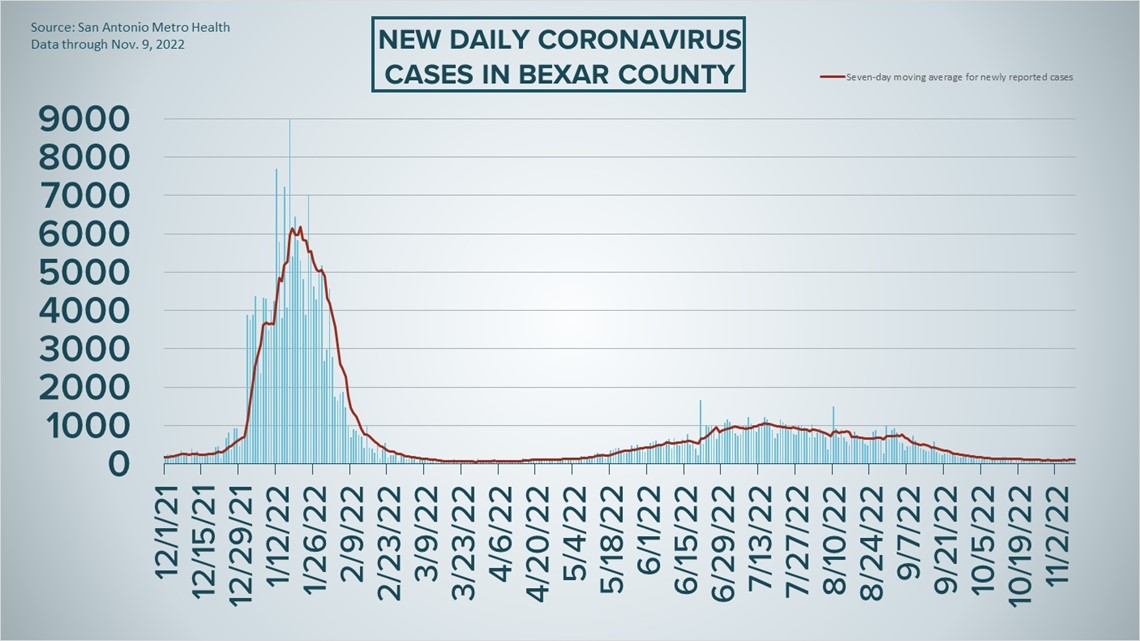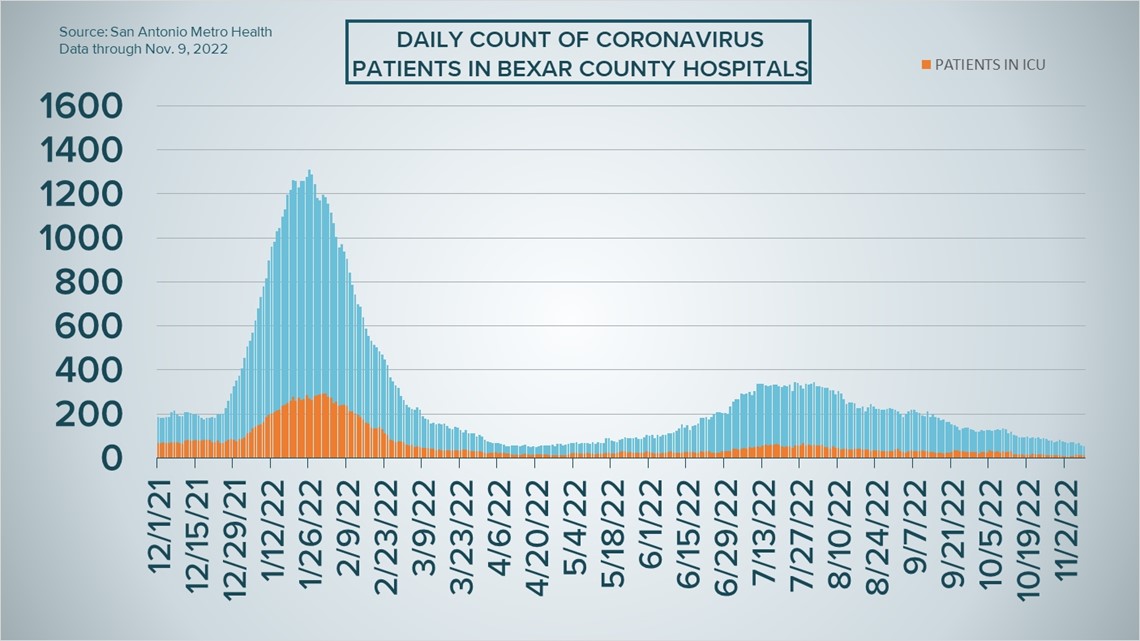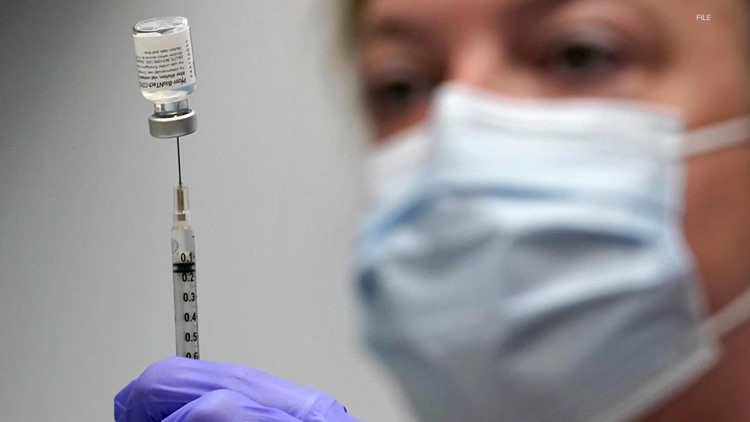SAN ANTONIO — Coronavirus hospitalizations in the San Antonio area have fallen to their lowest levels since late April, even as the start of November brings a slight uptick in new cases.
118 infections were reported Wednesday by Metro Health officials, capping a seven-day stretch that saw a total of 765 cases reported in Bexar County. The previous week, by comparison, yielded 661 cases in the community.
As a result, the seven-day case average returned to triple-digits this week, though there is no sign the bump is of major concern as Metro Health's risk level for COVID-19 spread remains at "low" and "improving."
Meanwhile, 53 patients were in local hospitals receiving treatment for COVID-19 symptoms Wednesday, 11 of which are in intensive care. Local hospitalizations have fallen by 29% since the start of the month and by 58% since Oct. 9.
No-cost vaccine clinics organized by the county will resume Thursday, on the east side.
More than 650,000 coronavirus infections have been reported in the San Antonio area since the pandemic began, though the number of at-home tests that went unreported likely numbers in the thousands. Just five COVID-19-related deaths have been reported since the start of October.
How Bexar County is trending




Vaccine progress in Bexar County
The following numbers are provided by San Antonio Metro Health. A full breakdown can be found here.
- 1,481,332 eligible Bexar County residents are fully vaccinated as of Oct. 10, which is about 74% of the total population over 6 months old.
- 591,339 eligible Bexar County residents have received a COVID-19 booster shot as of Oct. 10, which is 40% percent of the population over 4 years old.
The CDC states that "when a high percentage of the community is immune to a disease (through vaccination and/or prior illness)," that community will have reached herd immunity, "making the spread of this disease from person to person unlikely."
The City of San Antonio breaks down the vaccination rates by zip code on Metro Health's Vaccination Statistics page.
Coronavirus in Texas
The total number of coronavirus cases in the state grew by 2,249 on Wednesday, according to the Texas Department of State Health Services. That total includes 1,247 new confirmed cases and 1,002 new probable cases. More details can be found on this page.
Wednesday's figures bring the total number of Texans diagnosed with COVID-19 to more than 7.94 million.
Meanwhile, 11 more Texans have died from virus complications, the state reported Wednesday, raising the statewide death toll to 89,662.
Coronavirus symptoms
The symptoms of coronavirus can be similar to the flu or a bad cold. Symptoms include fever or chills, cough, shortness of breath or difficulty breathing, fatigue, muscle or body aches, headache, new loss of taste or smell sore throat, congestion or runny nose, nausea or vomiting, and diarrhea, according to the Centers for Disease Control.
Most healthy people will have mild symptoms. A study of more than 72,000 patients by the Centers for Disease Control in China showed 80 percent of the cases there were mild.
But infections can cause pneumonia, severe acute respiratory syndrome, kidney failure, and even death, according to the World Health Organization. Older people with underlying health conditions are most at risk.
Experts determined there was consistent evidence these conditions increase a person's risk, regardless of age:
- Chronic kidney disease
- COPD (chronic obstructive pulmonary disease)
- Obesity (BMI of 30 or higher)
- Immunocompromised state (weakened immune system) from solid organ transplant
- Serious heart conditions, such as heart failure, coronary artery disease, or cardiomyopathies
- Sickle cell disease
- Type 2 diabetes
- The CDC believes symptoms may appear anywhere from two to 14 days after being exposed.
Human coronaviruses are usually spread...
- Between people who are in close contact with one another (within about 6 feet).
- Through respiratory droplets produced when an infected person coughs, sneezes or talks. These droplets can land in the mouths or noses of people who are nearby or possibly be inhaled into the lungs.
- Some recent studies have suggested that COVID-19 may be spread by people who are not showing symptoms.
Help stop the spread of coronavirus
- Stay home when you are sick.
- Eat and sleep separately from your family members
- Use different utensils and dishes
- Cover your cough or sneeze with your arm, not your hand.
- If you use a tissue, throw it in the trash.
Find a testing location
City officials recommend getting a COVID-19 test if you experience fever or chills, cough, shortness of breath or difficulty breathing, fatigue, muscle or body aches, headache, new loss of taste or smell, sore throat, congestion or runny nose, nausea or vomiting, or diarrhea.
Here's a Testing Sites Locator to help you find the testing location closest to you in San Antonio.
Latest Coronavirus Headlines
- COVID Tracker: Hospitalizations down nearly 80% since August 1 in San Antonio
- Shanghai Disney closes as China ramps up COVID curbs
- What is the "tri-demic" and when to see a doctor?
- Smith County OKs nearly $3.7 million in COVID-19 federal funding to improve city of Winona sewer system
- China launches a COVID-19 vaccine inhaled through the mouth
- Test scores show historic COVID setbacks for kids across US



